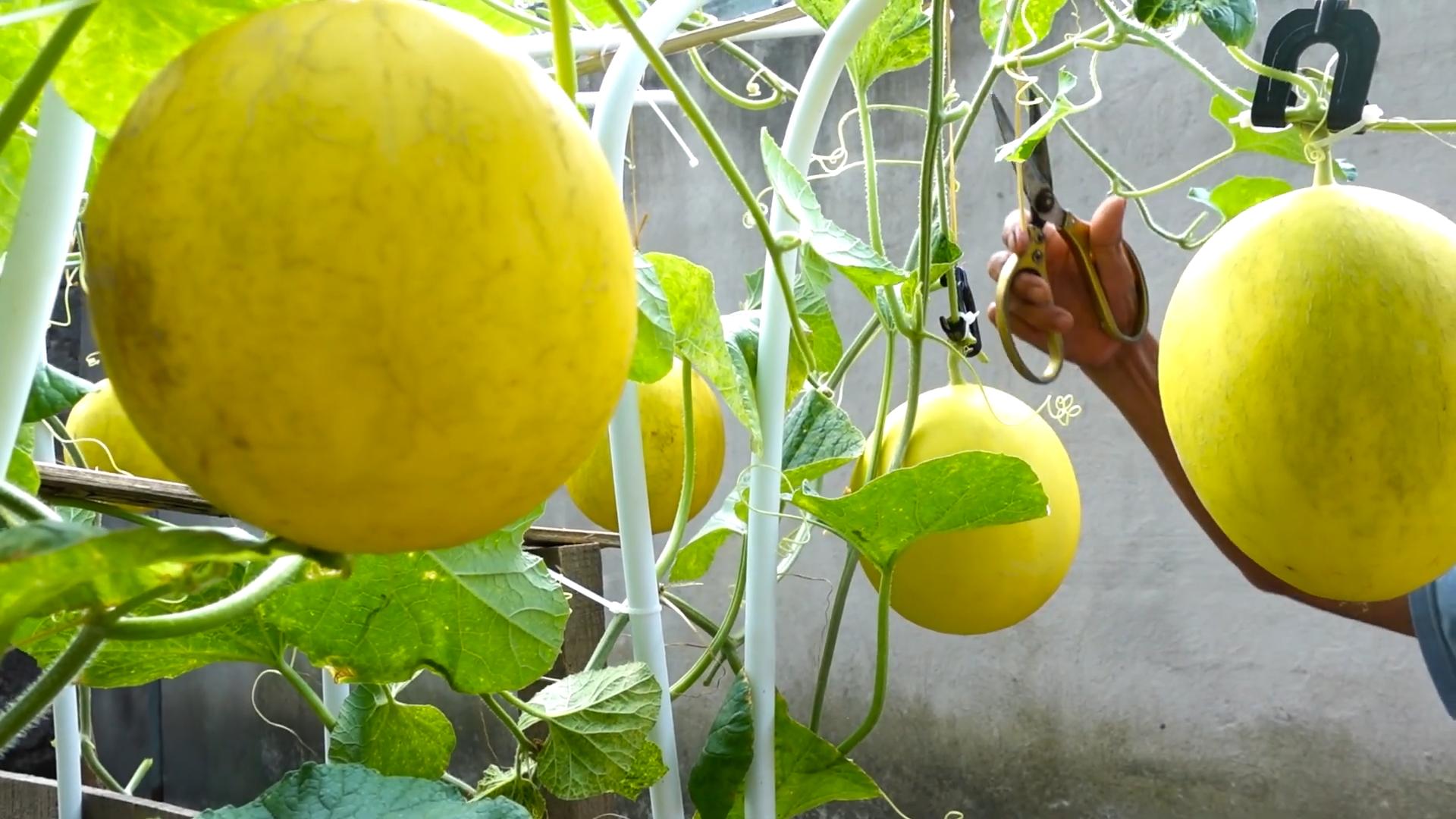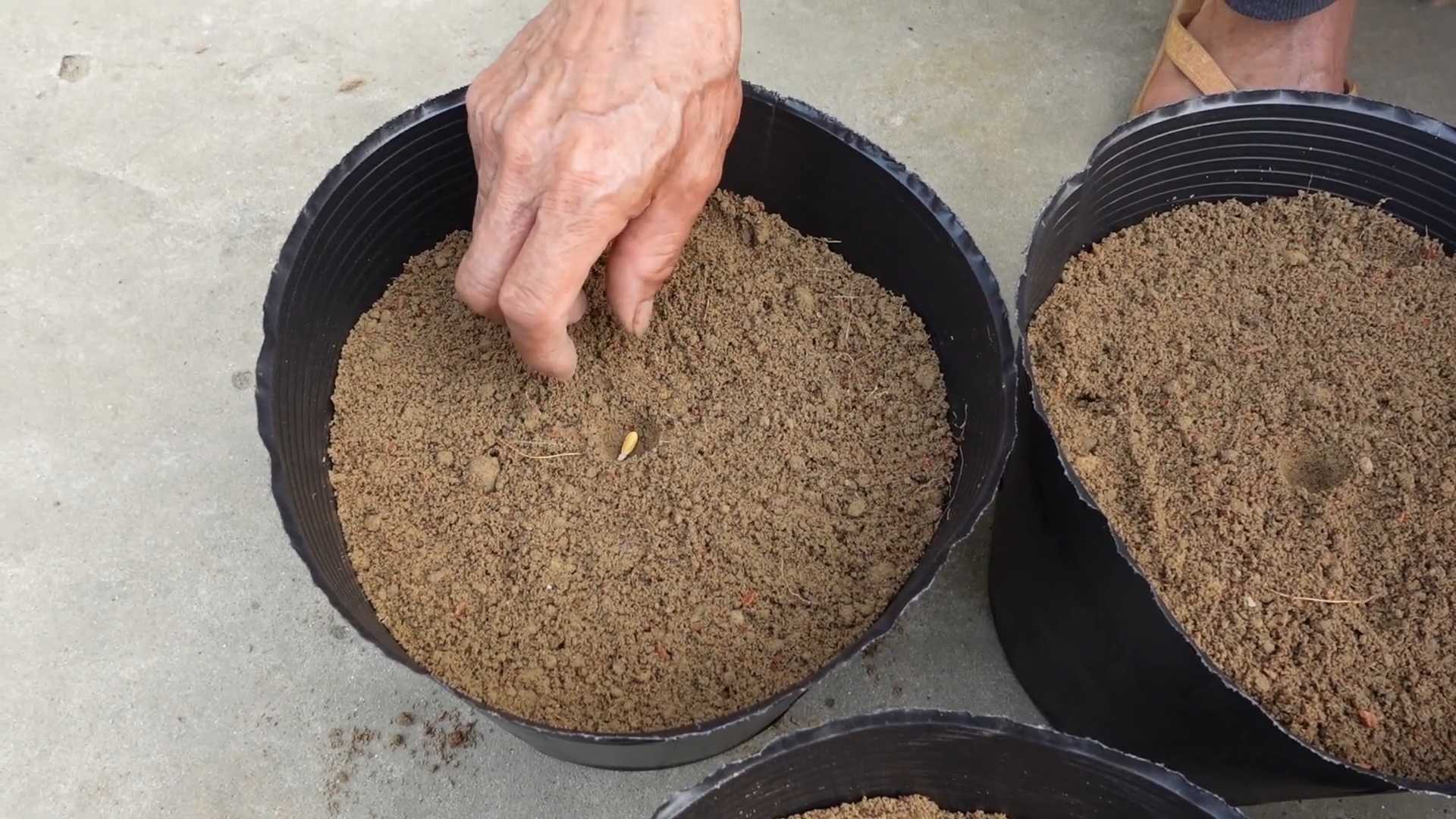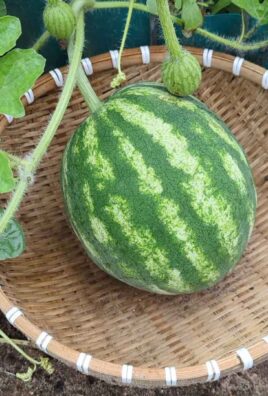Sweet Cantaloupe Growing Tips are what every home gardener dreams of! Imagine biting into a juicy, perfectly ripe cantaloupe, bursting with flavor, knowing you nurtured it from seed to table. Forget those bland, store-bought melons – we’re talking about homegrown sweetness that will blow your mind. But let’s be honest, growing cantaloupe can feel a little intimidating, right? That’s where these DIY tricks and hacks come in!
For centuries, cantaloupe has been a symbol of summer abundance and a delicious treat enjoyed across cultures. From ancient Egypt, where it was prized by royalty, to modern-day picnics, this melon has a rich history. But getting that perfect cantaloupe flavor isn’t always easy. Many gardeners struggle with issues like vine diseases, blossom end rot, or simply not getting the sweetness they crave.
That’s why I’ve compiled these easy-to-follow sweet cantaloupe growing tips and DIY solutions. I’m going to share my secrets for creating the ideal growing environment, preventing common problems, and ensuring you harvest the sweetest, most flavorful cantaloupes you’ve ever tasted. Get ready to transform your garden into a cantaloupe paradise!

Growing the Sweetest Cantaloupe: My Foolproof DIY Guide
Hey there, fellow gardening enthusiasts! I’m so excited to share my secrets for growing unbelievably sweet and juicy cantaloupes right in your own backyard. I’ve experimented with different techniques over the years, and I’ve finally nailed down a method that consistently produces cantaloupes bursting with flavor. Get ready to impress your friends and family with your homegrown sweetness!
Choosing the Right Cantaloupe Variety
Before we even get our hands dirty, let’s talk about variety. Not all cantaloupes are created equal! Some are naturally sweeter and more flavorful than others. Here are a few of my personal favorites:
* Athena: This is a classic choice for a reason. It’s known for its exceptional sweetness and disease resistance.
* Hales Best Jumbo: An heirloom variety that offers a rich, old-fashioned cantaloupe flavor.
* Ambrosia: As the name suggests, this cantaloupe is truly divine. It’s incredibly sweet and has a smooth, creamy texture.
* Sugar Cube: If you’re short on space, this compact variety is perfect. It produces small, but incredibly sweet, cantaloupes.
* Galia: While technically a hybrid between a cantaloupe and a honeydew, it offers a unique and delicious flavor profile with a hint of spice.
Preparing Your Garden Bed: The Foundation for Success
Cantaloupes are sun-loving, nutrient-hungry plants. Giving them the right start is crucial.
* Sunlight: Cantaloupes need at least 6-8 hours of direct sunlight per day. Choose a location in your garden that gets plenty of sunshine.
* Soil: Well-drained soil is essential. Cantaloupes hate having wet feet! Amend your soil with plenty of compost or well-rotted manure to improve drainage and fertility.
* pH: Cantaloupes prefer a slightly acidic to neutral soil pH (6.0-7.0). You can test your soil pH with a simple soil testing kit.
* Raised Beds (Optional): I’ve found that growing cantaloupes in raised beds can significantly improve drainage and soil temperature, leading to earlier and more abundant harvests.
Step-by-Step Planting Guide
Now for the fun part – getting those seeds in the ground!
1. Start Seeds Indoors (Optional): To get a head start on the growing season, I like to start my cantaloupe seeds indoors about 3-4 weeks before the last expected frost. Sow the seeds in peat pots or seed trays filled with seed-starting mix. Keep the soil moist and warm (around 70-80°F). Once the seedlings have developed a few true leaves, they’re ready to transplant.
2. Direct Sowing: If you live in a warmer climate with a long growing season, you can direct sow cantaloupe seeds directly into the garden. Wait until the soil has warmed up to at least 65°F. Plant the seeds about 1 inch deep and 18-24 inches apart.
3. Transplanting Seedlings: If you started your seeds indoors, harden them off before transplanting them into the garden. This means gradually exposing them to outdoor conditions over a period of a week or so. Choose a cloudy day to transplant to minimize stress on the seedlings. Dig a hole slightly larger than the root ball, gently remove the seedling from its container, and place it in the hole. Backfill with soil and water thoroughly.
4. Spacing: Cantaloupes need plenty of room to spread out. Space the plants 18-24 inches apart in rows that are 4-6 feet apart.
5. Watering: Water deeply and regularly, especially during hot, dry weather. Aim to keep the soil consistently moist, but not waterlogged. I prefer to water in the morning to allow the foliage to dry before nightfall, which helps prevent fungal diseases.
Nurturing Your Cantaloupe Plants: The Secret to Sweetness
Once your cantaloupe plants are established, it’s time to focus on providing them with the nutrients and care they need to thrive.
* Fertilizing: Cantaloupes are heavy feeders. I like to fertilize them every 2-3 weeks with a balanced fertilizer (e.g., 10-10-10) or a fertilizer specifically formulated for melons. You can also use organic fertilizers like compost tea or fish emulsion.
* Mulching: Apply a layer of mulch around your cantaloupe plants to help retain moisture, suppress weeds, and regulate soil temperature. I prefer to use organic mulches like straw or shredded leaves.
* Pruning (Optional): Some gardeners prune their cantaloupe plants to encourage larger fruit and better air circulation. If you choose to prune, remove any suckers (small shoots that grow from the base of the plant) and any leaves that are touching the ground.
* Pollination: Cantaloupes rely on bees and other pollinators to produce fruit. If you’re not seeing a lot of bee activity in your garden, you can hand-pollinate the flowers. To do this, use a small paintbrush to transfer pollen from the male flowers (which have a long, thin stem) to the female flowers (which have a small fruit at the base).
* Supporting the Fruit: As your cantaloupes grow larger, they may need some support to prevent them from rotting on the ground. You can use melon cradles, slings made from pantyhose, or even just place them on a bed of straw.
Protecting Your Cantaloupes from Pests and Diseases
Unfortunately, cantaloupes are susceptible to a few pests and diseases. Here’s how to protect your precious crop:
* Cucumber Beetles: These pesky beetles can transmit diseases and damage the foliage. I control them by handpicking them off the plants or using insecticidal soap.
* Squash Bugs: Squash bugs can also damage cantaloupe plants. I control them by handpicking them off the plants and destroying their eggs.
* Powdery Mildew: This fungal disease can cause a white, powdery coating on the leaves. I prevent powdery mildew by ensuring good air circulation and avoiding overhead watering. If powdery mildew does occur, I treat it with a fungicide.
* Fusarium Wilt: This soilborne disease can cause the plants to wilt and die. I prevent fusarium wilt by planting disease-resistant varieties and practicing crop rotation.
Harvesting Your Sweet Rewards
The moment you’ve been waiting for! Knowing when to harvest your cantaloupes is key to getting that perfect sweetness.
1. Visual Cues: Look for a change in color from green to tan or yellowish-tan. The netting on the rind should also become more pronounced.
2. The Slip Test: This is the most reliable way to tell if a cantaloupe is ripe. Gently press on the stem where it attaches to the fruit. If the stem slips easily from the fruit, it’s ready to harvest.
3. Aromatic Test: A ripe cantaloupe will have a sweet, musky aroma.
4. Sound Test: Give the cantaloupe a gentle thump. A ripe cantaloupe will sound hollow.
5. Harvesting: Once you’ve determined that a cantaloupe is ripe, gently twist it off the vine. Handle the fruit carefully to avoid bruising.
Tips for Maximizing Sweetness
Okay, here are my extra special tips that I swear by for getting the *absolute* sweetest cantaloupes possible:
* Water Wisely: Reduce watering a week or two before harvest. This concentrates the sugars in the fruit. But don’t let them completely dry out!
* Potassium Power: Potassium is essential for sugar production. Amend your soil with potassium-rich amendments like wood ash or kelp meal.
* Sun Exposure: Make sure the cantaloupes get plenty of sunlight as they ripen.
* Patience is Key: Don’t be tempted to harvest your cantaloupes too early. Let them ripen fully on the vine for the best flavor.
* Post-Harvest Ripening: Even after harvesting, cantaloupes will continue to ripen slightly. Store them at room temperature for a few days to allow them to develop their full sweetness.
Enjoying Your Homegrown Cantaloupe
Congratulations! You’ve successfully grown your own sweet and juicy cantaloupes. Now it’s time to enjoy the fruits (or rather, melons) of your labor.
* Eat it Fresh: There’s nothing quite like biting into a freshly harvested cantaloupe.
* Make a Smoothie: Cantaloupe adds a refreshing sweetness to smoothies.
* Grill It: Grilled cantaloupe is a surprisingly delicious treat.
* Add it to Salads: Cantaloupe pairs well with salty cheeses and savory herbs.
* Make

Conclusion
Achieving that perfectly sweet and juicy cantaloupe at home might seem like a gardener’s dream, but with these simple yet effective DIY tricks, it’s absolutely within your reach. We’ve explored how strategic pruning, consistent watering, and the magic of Epsom salts can transform your cantaloupe patch from a source of disappointment to a haven of deliciousness.
But why is this DIY approach a must-try? Because it puts you in control. You’re not relying on luck or hoping for the best; you’re actively shaping the growing environment to favor sweetness and flavor development. Store-bought cantaloupes, while convenient, often lack the intense sweetness and aroma of a homegrown melon nurtured with care. This method allows you to tailor the growing process to your specific climate and soil conditions, maximizing your chances of success.
Beyond the core techniques we’ve discussed, there are variations you can explore to further enhance your cantaloupe growing experience. Consider experimenting with different types of mulch to retain moisture and suppress weeds. Straw, wood chips, or even black plastic mulch can all have a positive impact. You could also try companion planting. Marigolds, for instance, are known to deter pests, while basil can improve the overall health of your cantaloupe plants.
Another exciting variation involves grafting. If you’re feeling adventurous, you can graft your cantaloupe scion onto a more vigorous rootstock, such as a squash or pumpkin. This can improve disease resistance and overall plant health, leading to even sweeter and more abundant harvests.
Remember, the key to success lies in consistent observation and adaptation. Pay close attention to your plants, monitor the weather, and adjust your watering and feeding schedule accordingly. Don’t be afraid to experiment and try new things. Gardening is a journey of learning and discovery, and every season brings new opportunities to refine your techniques.
Ultimately, growing your own sweet cantaloupe is a rewarding experience that connects you with nature and provides you with a delicious and healthy treat. It’s a chance to savor the fruits (or rather, melons) of your labor and appreciate the simple pleasures of life. So, ditch the bland store-bought melons and embark on this DIY adventure. You’ll be amazed at the difference it makes.
We wholeheartedly encourage you to try these DIY tricks and share your experiences with us. Let us know what worked for you, what challenges you faced, and any variations you discovered along the way. Your insights can help other gardeners achieve their cantaloupe-growing dreams. Share your photos, tips, and stories in the comments section below. Let’s build a community of cantaloupe enthusiasts and spread the joy of homegrown sweetness! Mastering these **sweet cantaloupe growing tips** will transform your garden and your taste buds.
Frequently Asked Questions (FAQ)
Q: How do I know when my cantaloupe is ripe?
A: Determining ripeness is crucial for enjoying the sweetest cantaloupe. Several indicators can help you. First, look for a change in color. The rind should transition from green to a tan or yellowish hue. Second, check the stem. A ripe cantaloupe will easily slip from the vine with a gentle tug, leaving a smooth, shallow indentation. This is known as the “full slip” stage. Finally, give the cantaloupe a sniff. A ripe melon will have a sweet, musky aroma, especially at the blossom end. Avoid cantaloupes that feel soft or have bruises.
Q: How often should I water my cantaloupe plants?
A: Consistent watering is essential, especially during fruit development. Water deeply and regularly, aiming for about 1-2 inches of water per week. Avoid overhead watering, as this can promote fungal diseases. Instead, use a soaker hose or drip irrigation to deliver water directly to the roots. During hot, dry periods, you may need to water more frequently. Check the soil moisture regularly and adjust your watering schedule accordingly. Once the fruits start to ripen, you can reduce watering slightly to concentrate the sugars and enhance sweetness.
Q: What is the best type of fertilizer to use for cantaloupe?
A: Cantaloupes benefit from a balanced fertilizer that provides essential nutrients for growth and fruit development. A fertilizer with an NPK ratio of 10-10-10 or 14-14-14 is a good starting point. Apply the fertilizer according to the package instructions, typically at planting and again when the fruits begin to form. You can also supplement with organic fertilizers, such as compost or aged manure, to improve soil health and provide a slow-release source of nutrients. Avoid over-fertilizing, as this can lead to excessive foliage growth at the expense of fruit production.
Q: How do Epsom salts help cantaloupe plants?
A: Epsom salts (magnesium sulfate) provide magnesium, an essential nutrient for plant growth. Magnesium plays a vital role in photosynthesis, chlorophyll production, and nutrient uptake. Applying Epsom salts to cantaloupe plants can help improve their overall health, increase fruit sweetness, and enhance disease resistance. Dissolve 1-2 tablespoons of Epsom salts in a gallon of water and spray the foliage or water the base of the plants every 2-3 weeks. Be careful not to overdo it, as excessive magnesium can interfere with calcium uptake.
Q: How can I protect my cantaloupe plants from pests and diseases?
A: Cantaloupe plants are susceptible to various pests and diseases, including aphids, squash bugs, vine borers, powdery mildew, and fusarium wilt. To protect your plants, practice good garden hygiene. Remove any diseased or infested leaves and debris. Use row covers to protect young plants from pests. Encourage beneficial insects, such as ladybugs and lacewings, which prey on aphids and other pests. Apply organic pesticides, such as neem oil or insecticidal soap, as needed. Choose disease-resistant varieties of cantaloupe and practice crop rotation to prevent soilborne diseases. Ensure good air circulation around the plants to reduce humidity and prevent fungal diseases.
Q: Can I grow cantaloupe in containers?
A: Yes, you can grow cantaloupe in containers, but you’ll need to choose a large container (at least 20 gallons) and provide adequate support for the vines. Select a bush or dwarf variety of cantaloupe that is better suited for container growing. Use a well-draining potting mix and provide regular watering and fertilization. Place the container in a sunny location that receives at least 6-8 hours of sunlight per day. You may need to hand-pollinate the flowers if there are not enough pollinators in your area.
Q: What are some good companion plants for cantaloupe?
A: Companion planting can benefit cantaloupe plants by attracting pollinators, deterring pests, and improving soil health. Some good companion plants for cantaloupe include marigolds, basil, nasturtiums, oregano, and thyme. Marigolds deter nematodes and other soil pests. Basil repels aphids and other insects. Nasturtiums attract beneficial insects and act as a trap crop for aphids. Oregano and thyme are aromatic herbs that can deter pests and improve the flavor of the cantaloupe.
Q: How long does it take for cantaloupe to mature?
A: The time it takes for cantaloupe to mature depends on the variety and growing conditions. Generally, cantaloupe takes 70-90 days from planting to harvest. Warmer temperatures and ample sunlight will speed up the ripening process. Be patient and monitor your plants closely for signs of ripeness.
Q: What should I do if my cantaloupe plants are not producing fruit?
A: Several factors can contribute to a lack of fruit production in cantaloupe plants. Ensure that your plants are receiving enough sunlight (at least 6-8 hours per day). Check the soil pH and nutrient levels. Cantaloupe prefers a slightly acidic to neutral soil pH (6.0-7.0) and requires adequate levels of nitrogen, phosphorus, and potassium. Make sure your plants are being properly pollinated. If there are not enough bees or other pollinators in your area, you may need to hand-pollinate the flowers. Avoid over-watering or over-fertilizing, as this can inhibit fruit production. Finally, check for pests and diseases that may be affecting the health of your plants.





Leave a Comment